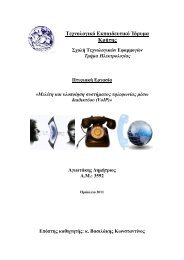Ψηφιακό Τεκμήριο
Ψηφιακό Τεκμήριο
Ψηφιακό Τεκμήριο
Create successful ePaper yourself
Turn your PDF publications into a flip-book with our unique Google optimized e-Paper software.
8.1.2 Analog/ISDN Line Security Policy 32<br />
Created by or for the SANS Institute. Feel free to modify or use for your<br />
organization. If you have a policy to contribute, please send e-mail to<br />
stephen@sans.edu<br />
1.0 Purpose<br />
This document explains analog and ISDN line acceptable use and<br />
approval policies and procedures. This policy covers two distinct uses of analog/ISDN<br />
lines: lines that are to be connected for the sole purpose of fax sending and receiving,<br />
and lines that are to be connected to computers.<br />
2.0 Scope<br />
This policy covers only those lines that are to be connected to a point inside<br />
building and testing sites. It does not pertain to ISDN/phone lines<br />
that are connected into employee homes, PBX desktop phones, and those lines used<br />
by Telecom for emergency and non-corporate information purposes.<br />
3.0 Policy<br />
3.1 Scenarios & Business Impact<br />
There are two important scenarios that involve analog line misuse, which we attempt<br />
to guard against through this policy. The first is an outside attacker who calls a set of<br />
analog line numbers in the hope of connecting to a computer that has a modem<br />
attached to it. If the modem answers (and most computers today are configured outof-the-box<br />
to auto-answer) from inside premises, then there is the<br />
possibility of breaching 's internal network through that computer,<br />
unmonitored. At the very least, information that is held on that computer alone can be<br />
compromised. This potentially results in the loss of millions of dollars worth of<br />
corporate information.<br />
The second scenario is the threat of anyone with physical access into a facility being able to use a modem-equipped laptop or desktop computer. In<br />
this case, the intruder would be able to connect to the trusted networking of<br />
through the computer's Ethernet connection, and then call out to<br />
an unmonitored site using the modem, with the ability to siphon <br />
information to an unknown location. This could also potentially result in the<br />
substantial loss of vital information. Specific procedures for addressing the security<br />
risks inherent in each of these scenarios follow.<br />
3.2 Facsimile Machines<br />
As a rule, the following applies to requests for fax and analog lines:<br />
• Fax lines are to be approved for departmental use only.<br />
• No fax lines will be installed for personal use.<br />
32 http://www.sans.org/resources/policies/Analog_Line_Policy.pdf<br />
141

















